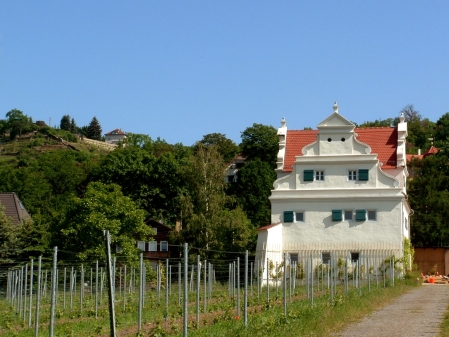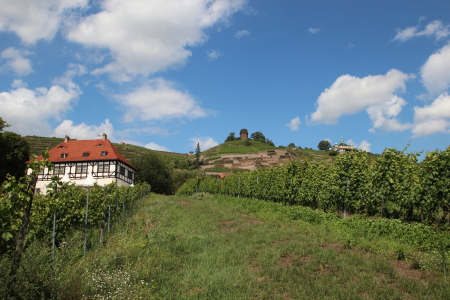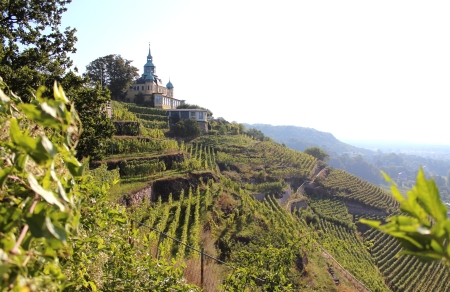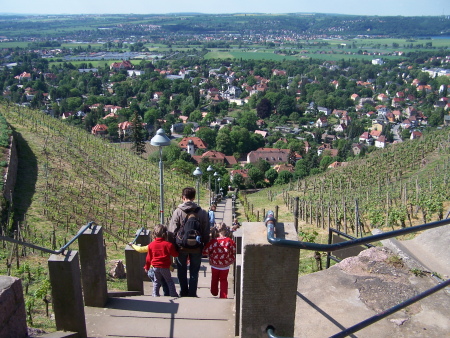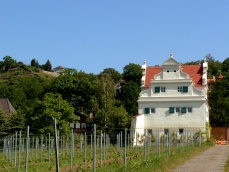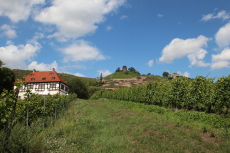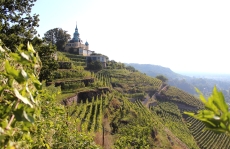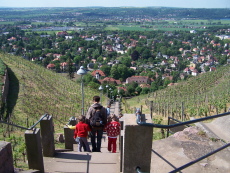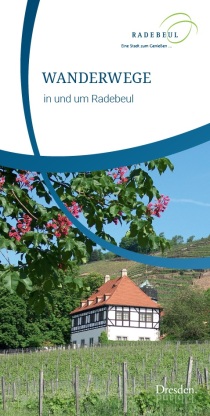Hike through the Oberlößnitz
From the stop on tram line 4 "Zinzendorfstraße" or from the S 1 Radebeul-Ost S-Bahn stop, walk along Zinzendorfstraße, cross Meißner Straße and continue along August-Bebel-Straße. At the end of August-Bebel-Straße, turn left onto Augustusweg and take the next right onto Eduard-Bilz-Straße.
Passing the newly built residential park "Am Albertsberg", Haus Albertsberg forms a striking conclusion. Haus Albertsberg is a listed manor house, which already stood on the same site in 1660 as a stone residential building with a wine press. The house was remodelled in 1898, giving it its current neo-baroque character with a tendency towards Art Nouveau. Passing Haus Albertsberg, you will reach the former Bilzsanatorium on the right.
This was named after Friedrich Eduard Bilz, a well-known naturopath. Bilz converted the wash house into a bathing parlour and the cowshed into a men's bath and was granted a licence to operate the sanatorium in September 1892. Due to the great demand, he had a four-storey Swiss-style spa centre built according to plans by the Ziller brothers. After a chequered history, it was extensively renovated in 2007 and is now used for residential purposes. Following the path past the Bilzsanatorium (Straken), you will see the "Haus in der Sonne", a two-storey Baroque vineyard house built in 1770 in the middle of the vineyards as a country residence for the Electoral Saxon mint factor Georg Christian Städter.
Continuing along the "Straken", you will discover well-preserved vineyard walls on your left, which are becoming increasingly wooded. At the end of the ascent, turn left into the hollow path and follow it down into the valley. On your way down into the valley, you pass the back of the "Haus in der Sonne" once again before the path becomes narrower and lined with vineyard walls.
Shortly before the end of the path, turn round and you will see the Balberg, on top of which the "Steinerne Schnecke" is enthroned. It was built in the early 17th century from syenite stones and is unrivalled in Germany. Continue along the path and turn right into Weinbergstraße. You are now right at the gates of the DREI HERREN winery, the core of which dates back to 1714. After falling into serious disrepair, the building was restored between 1993 and 2005 by Mr Wolfgang Richter and art historian Dr Rainer Beck in line with its listed status and the DREI HERREN winery was founded. Perhaps you will sample a good drop of Radebeul wine here under the expert guidance of the Saxon Wine Queen of 2003.
Continuing along Weinbergstraße, you will come to the "Haus Lorenz", which was built in the 17th century. Today it is only used for residential purposes. Continuing along the idyllic Weinbergstraße, you will reach the Retzschgut, which was extensively renovated in 2006.
It includes a large vineyard where wine has been grown since 1649. The estate was named after the painter and professor at the Dresden Academy of Art Moritz Retzsch, known for his illustrations of Goethe's "Faust", among others. The current owner still cultivates the vineyard and founded his own wine-growing business in 1992. He serves his own wines in a wine tavern.
At the junction of Weinbergstraße and Hoflößnitzstraße, on the right-hand side is the Meinholdsche Turmhaus, an estate that has been cultivated and built on since the 16th century. For 100 years, the Meinhold family characterised the country estate with their taste, which presents itself as a pedant to the Hoflößnitz Winery Museum. Today, the historic estate is once again a household name as the Aust Winery. Friedrich Aust is continuing the tradition and revitalising the old winery.
Please turn left into Hoflößnitzstraße and then left into Bennostraße at the next junction. Along Bennostraße you will find many small residential and winegrowers' houses typical of the region. At the end of Bennostrasse, you will see the Bennoschlösschen on the left. It is the oldest manor house in Lößnitz that is still largely in its original state. It was built before 1580 as a vineyard residential tower. It was not named after the legendary patron saint, the canonised Bishop Benno, until the Romantic period. The picturesque Renaissance-style roof structures to the north and south of the building are remarkable.
Now follow Bennostraße with a slight right turn until it joins Augustusweg. The Haus Steinbach winery, which has been run by the Gerhardt family for over 40 years, is located on this small right turn. The winery is one of the oldest vineyards in Oberlößnitz and has been preserved in its original size and beauty to this day thanks to a great deal of dedication and commitment. The three-sided courtyard with large vaulted cellars and the adjoining manor house and park are a jewel in the Radebeul cultural landscape.
Once on Augustusweg, turn left and you will reach "Haus Sorgenfrei", one of the most architecturally significant manor houses in Lößnitz. The two-storey manor house, built in 1783, is considered to be the last remaining building in the so-called "Dresdner Zopfstil". The building complex was extensively renovated in 1995 and now houses a hotel.
Continue along Augustusweg and turn right at a small roundabout into Eduard-Bilz-Straße. On this section of the street you will find many houses of the same architectural style, the so-called "Zillerhäuser". These houses were designed and built by the Radebeul-based master builders Gebrüder Ziller.
At the end of Eduard-Bilz-Straße, turn left into Meißner Straße and from here you can take tram line 4 in the direction of Dresden or Weinböhla.
Details of the hike
| Distance: | ca. 5 km |
|---|---|
| Duration: | 2 Stunden |
| Height: | 100 m |
| Difficulty: | mittel |
In the brochure "Hiking trails in and around Radebeul" you will find these and many other hiking suggestions. Available from the tourist information centre.





